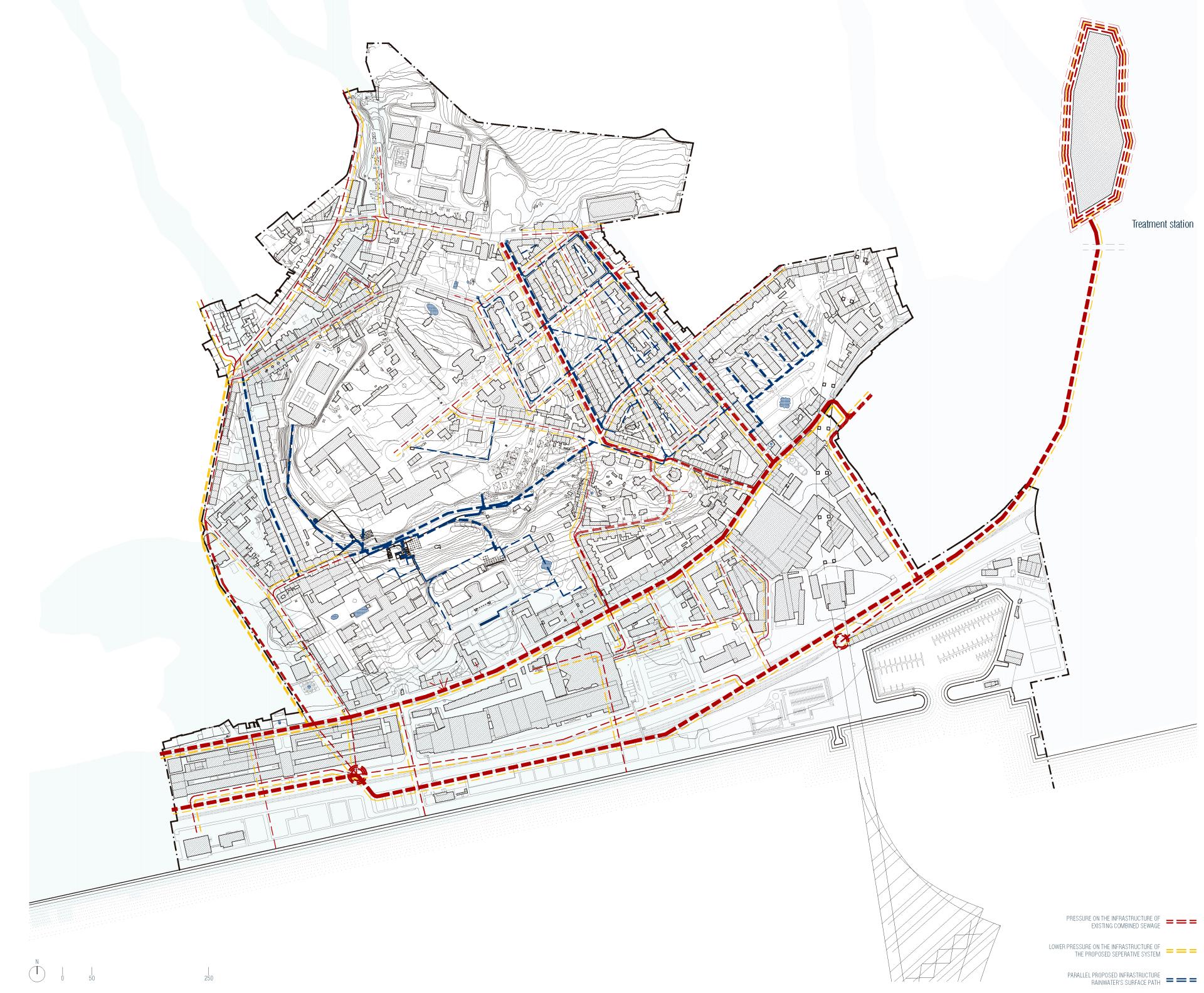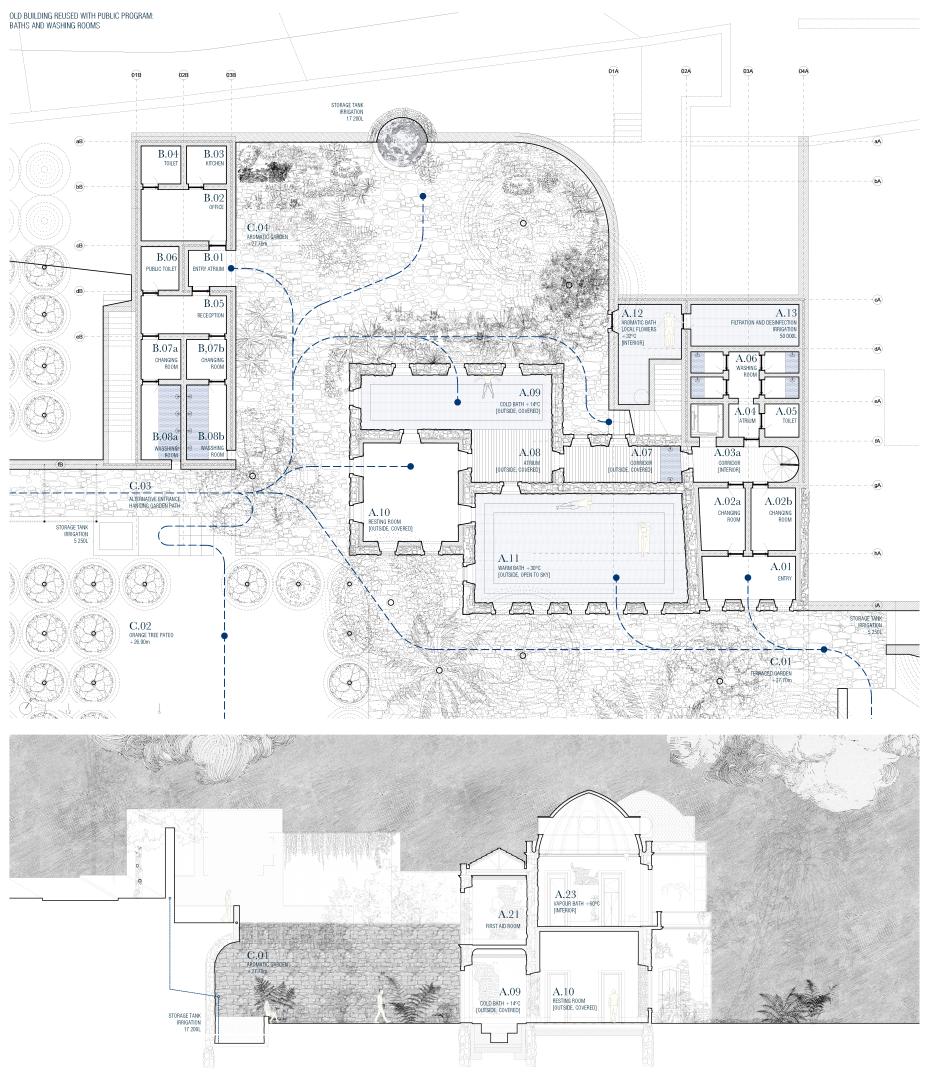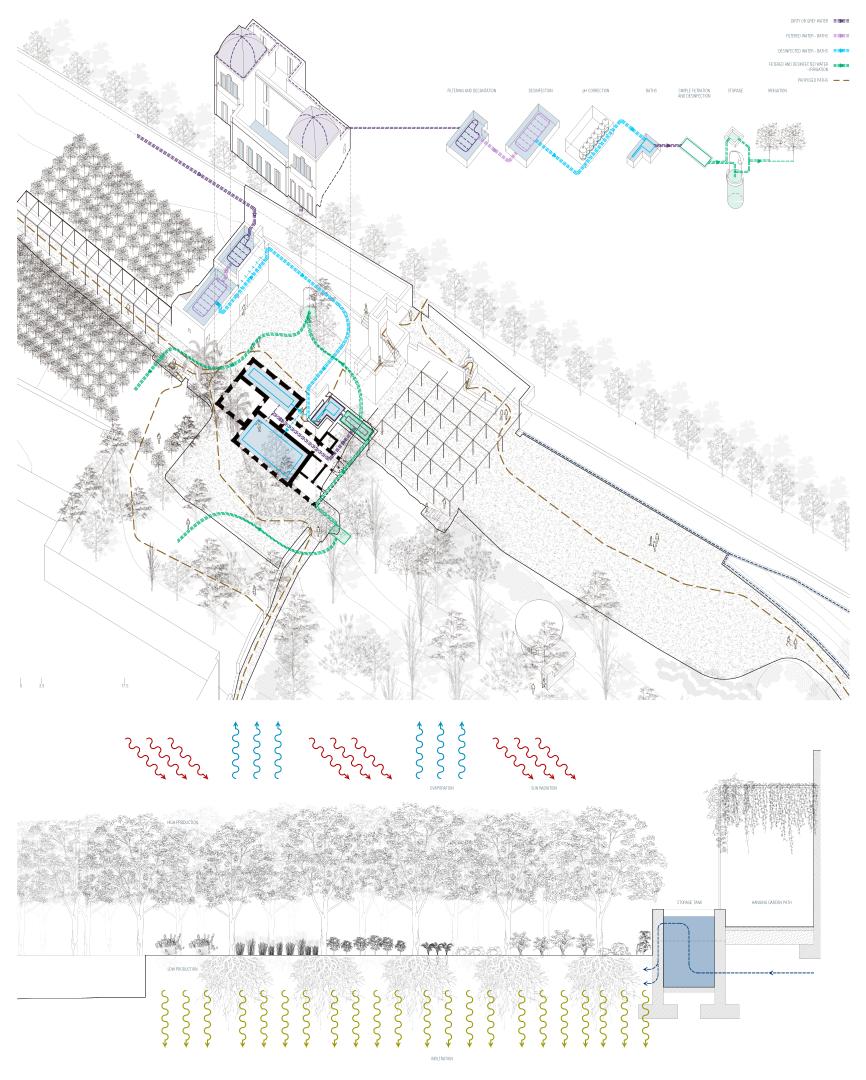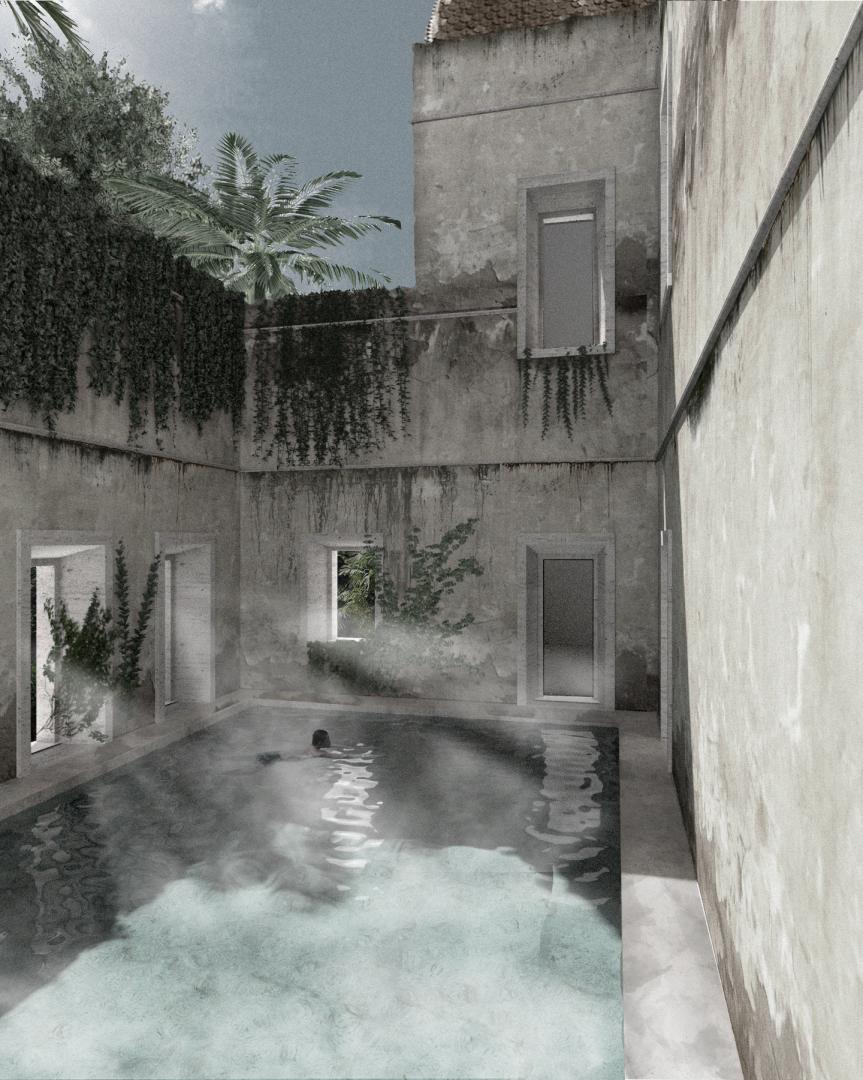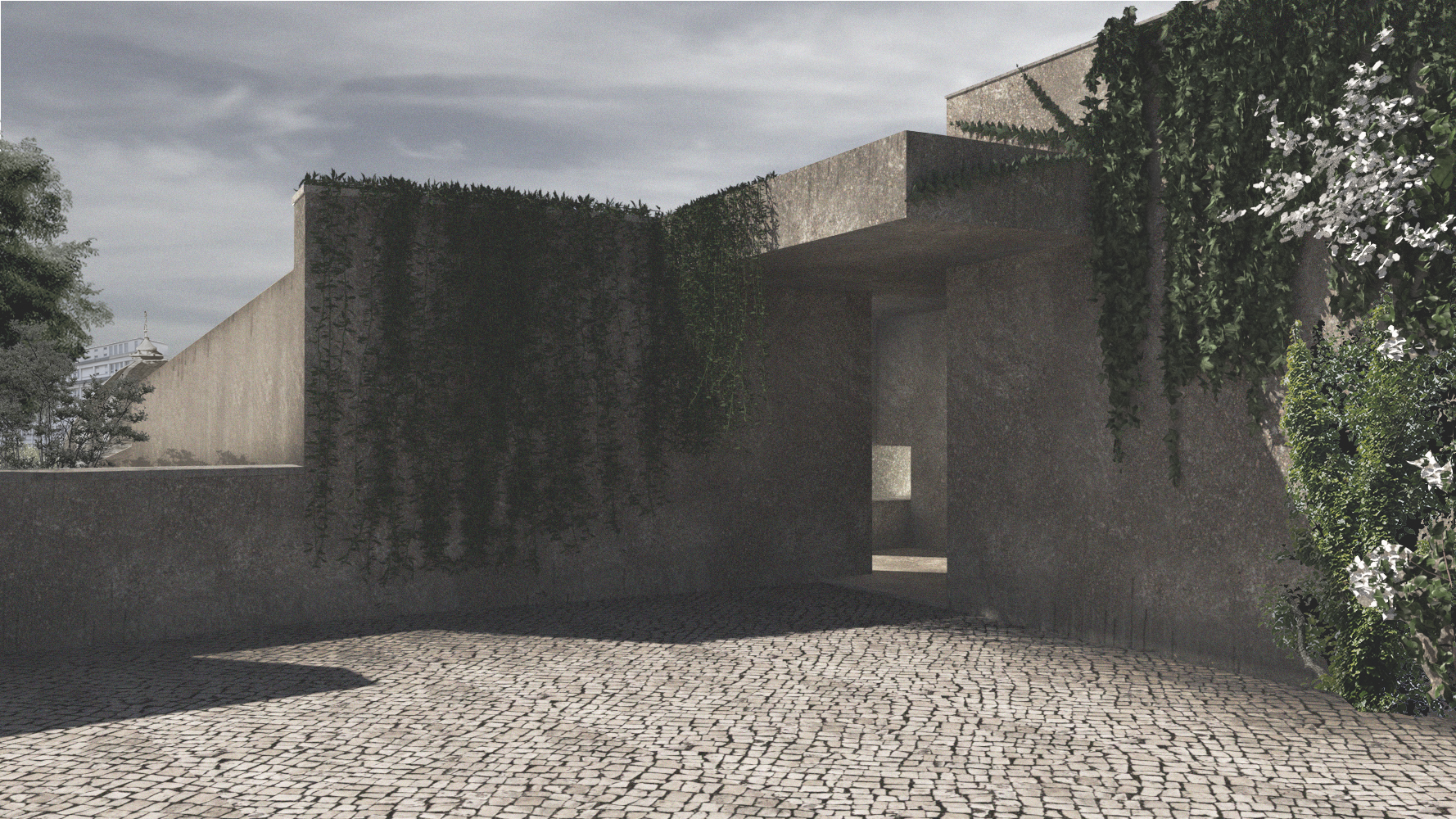The Countryside as Infrastructure
Basic information
Project Title
Full project title
Category
Project Description
With increasingly frequent phenomena of torrential rains, the soil's waterproofing and artificialization of the water’s course in the cities have complexified and overloaded the draining infrastructures. A transition from unitary to separative sewage system allows for the use of rainwater in ludic and productive paths where the water is held upstream and slowly distributed for the irrigation of gardens in the cities. The water cycle designs public space and reduces pressure on infrastructure.
Geographical Scope
Project Region
Urban or rural issues
Physical or other transformations
EU Programme or fund
Which funds
Description of the project
Summary
Cities tended to be founded near fertile and productive lands, where water was abundant. However, in times of growing soil waterproofing, the artificialization of the water’s course have complexified the hydraulic and natural water systems, making them unable to respond to the increasingly strong and frequent phenomena of torrential rains. Additionally, cities nearby the oceans suffer from simultaneous episodes of torrential rains and the direct tidal effects, overloading weak and insufficient drainage infrastructures.
Regardless of the place, under extreme circumstances there is an inverse, thus unnatural, movement in the infrastructures and they give in to pressure, causing direct discharges of the polluted flows into the receiving environment.
The concept proposes an addition to the unitary sewage, a parallel separative system, enabling a reduction in the load on the downstream infrastructures. The sewage separation allows for the use of rainwater, building recreational and productive paths along which the water is slown down, stored, filtered, disinfected, serving irrigation for local permeable areas. Therefore, the water cycle is incorporated in the design of the city. Usually, infrastructure is noisy and unpleasant and tends to be hidden out of sight. An inverse process is proposed: let us not hide infrastructure but use it to design the city.
A visible, street-level «aqueduct» leads the water through the city, but also uses the typological permanence of old, unused buildings for several program types: ludic (i.e. public baths, parks), services (i.e. showering and public changing rooms), infrastructure (storage, filtering and disinfection tanks) and production (gardens).
Cities are born and grow from water and this concept seeks its praise - through wasted rainwater - while promoting a balance of the ecological systems and reducing the overload on the existing infrastructures.
This idea was explored in Lisbon, but it is applicable in most places.
Key objectives for sustainability
The complex system of roads, highways and underground infrastructure is continuously increasing, constituting fracturing elements in the urban fabric. Also, the high degree of soil waterproofing means that the water picks every pollutant along the way which are then collected by the sewage system. When torrential rains, evermore stronger and frequent, hit the cities, the combined sewer is overloaded and discharges the polluted blend into the streets with enormous damages to the water cycle and natural ecosystems.
An addition to the combined sewage is a separative system that enables a reduction on the load downstream. A surface infrastructure – visible “aqueduct” – works upstream, parallel to the existing combined sewer. This rainwater drainage scheme allows the creation of controlled runoff conditions, reducing peak flows and erosion by increasing the volume of infiltrated and retained water. Visible and invisible ducts, benches, walls, stairs, tanks and drainpipes allow the continuity of the infrastructure in an urban environment, even when highly impermeable. Old buildings can be integrated in the proposed infrastructure, then feeding the newly permeable interior of housing blocks. Nature can be regenerated, increasing biodiversity in the city.
This gravitational system has an internal slope, allowing for constant pressure on the infrastructure and a slower flow of water, avoiding a lot of afterwards pumping, and is complemented by filtering and decanting structures that clean water to a certain degree and then channel it to different uses like, for example, the irrigation of productive gardens.
The wasted rainwater is now slown down, stored and integrated in (semi) permeable areas, operating on a territorial to landscape and local levels. The proposed infrastructures distribute water, feed the soil through infiltration making it more fertile but also promoting circularity, as it returns the water to its natural cycle, to vegetation, soil and bedsheets.
Key objectives for aesthetics and quality
Water is a scarce resource and by disciplining it in the territory, it gains an infrastructural meaning, more than just contemplative, with the landscaping potential it offers - allowing the definition of distinct and diverse atmospheres, but also generating cohesive and generous portions of nature in the city.
Happiness can literally be «planted» in the cities. Both the edible garden and the infrastructure create an intermediate landscape that negotiates urban and rural facts, where cultural, leisure, productive and natural atmospheres are summoned, building an immersive landscape, with no distance and contributing to the creation of places of intimacy between men, nature, water and the food grown.
These transition spaces take shape in surgical interventions, built with parsimony and fundamental design options – a hanging tree that shadows a passage to another place, an edible garden that marks the season’s changing, an aromatic garden that bursts in a chromatic and smelling experience, an old building and the acceptance of its time in the design, a tank that freshens a patio while storing rainwater, a syphon that seduces the entrance to a hidden place, visible ducts that shows the path of water, an invisible one that tells of the murmur of its movement, a water tank that mirrors the sky, a wall to separates us from a view giving meaning to the window after.
Atmospheres are richest with this fluctuation in light, shadow, humidity, smell, sound, color, taste, freshness, warmth, time. The materiality follows the genius loci and the vernacular wisdom of the place and its building ways. Most of all, it matters not if architecture or a flower build the atmosphere. The means to achieve it is less important than the experience provided. Atmospheres matter the most.
All these possibilities slow down the path from the noisy city and welcomes one to a more docile and natural place in a mediation of scale: from the landscape to the touch of hand and taste of the mouth.
Key objectives for inclusion
The new infrastructure is parallel to the existing one and, since it is visible and designs the city, it includes all elements and people who wish to be a part of it.
The housing blocks can be part of the infrastructure by changing their roof drainage path and collecting rainwater into storing tanks that feed several uses. The proposal goes further away and suggests changing the whole interior of the blocks to permeable areas, increasing its infiltration area, where edible gardens and public spaces can take shape, with the final use depending only on how the inhabitants wish to occupy it. Every person can have a possibility of having a portion of land to grow food, animals, do nothing, give others or open to public. Also, using old, unused buildings that become part of the infrastructure can give them a renewed, generous life.
There can be raised awareness regarding this «now wasted» resource if people become more sensible mediators and are included in the infrastructural process. This inclusive concept is applicable everywhere - in city centers, suburban areas and even in the countryside - and, in each place, it has the potential to enrich public and shared spaces for everyone to use. Also, each place needs a specific design adapted to its concrete reality and there is a great advantage in working with local institutions and residents because no one know the places better than them. Having them co-designing is only an add-up.
There is a possibility to allow every citizen that wishes this closer-to-nature relationship. Furthermore, people understand better things they can see and seeing the infrastructure allows them to comprehend it and even make sense of the whole water cycle, which can then raise awareness and have an effective impact on people’s everyday actions by working upstream and towards a more balanced planet.
Being both applicable everywhere and a parallel system to the existing one the infrastructure is accessible and affordable to all.
Physical or other transformations
Innovative character
The possibility of deviating the current rainwater flow to a surface drainage system, designing places for recreation, production, storage and infiltration, is an opportunity to design a holistic public space for everyone.
The draining capacities and virtues of the countryside are applicable to the city if we understand how landscape works. Making the infrastructure visible is a change in paradigm – by not hiding it but using it to design and integrate wasted rainwater in public spaces, we shall have a greater respect for water and its natural cycle. Being visible also means it is less complicated and more easily maintained.
Water is a major part of «man-made natural environment» but, since it is a scarce resource, it must be more than just contemplative, it needs to have an infrastructural potential. This is an infrastructural path along which one can grasp the totality of landscape in small portions of it. Lucius Burkchard said that we can only appreciate the landscape if we know how it works. Understanding the waters course, how it is slown down, stored, cleaned, distributed and how it affects a plant grow or simply freshen a place, it deepens the communities’ relationship with nature and the nature of things.
Delaying the water’s course and allowing its permanence intensifies spaces and their atmospheres. It also gives them an immanent character, combining the intimacy of water with the scale of landscape. The edible gardens that complement the infrastructure are also places of great familiarity and they add biological, nutritious and spatial biodiversity to the paths.
Conducting water and designing a garden is drawing time. The time, quietness and silence they offer is sometimes all that people need in cities.
This proposal is local-oriented, being based on contexts, vernacular construction systems and traditions, but it is highly transferable and replicated in different environments. These are local solutions to a global challenge.

